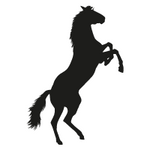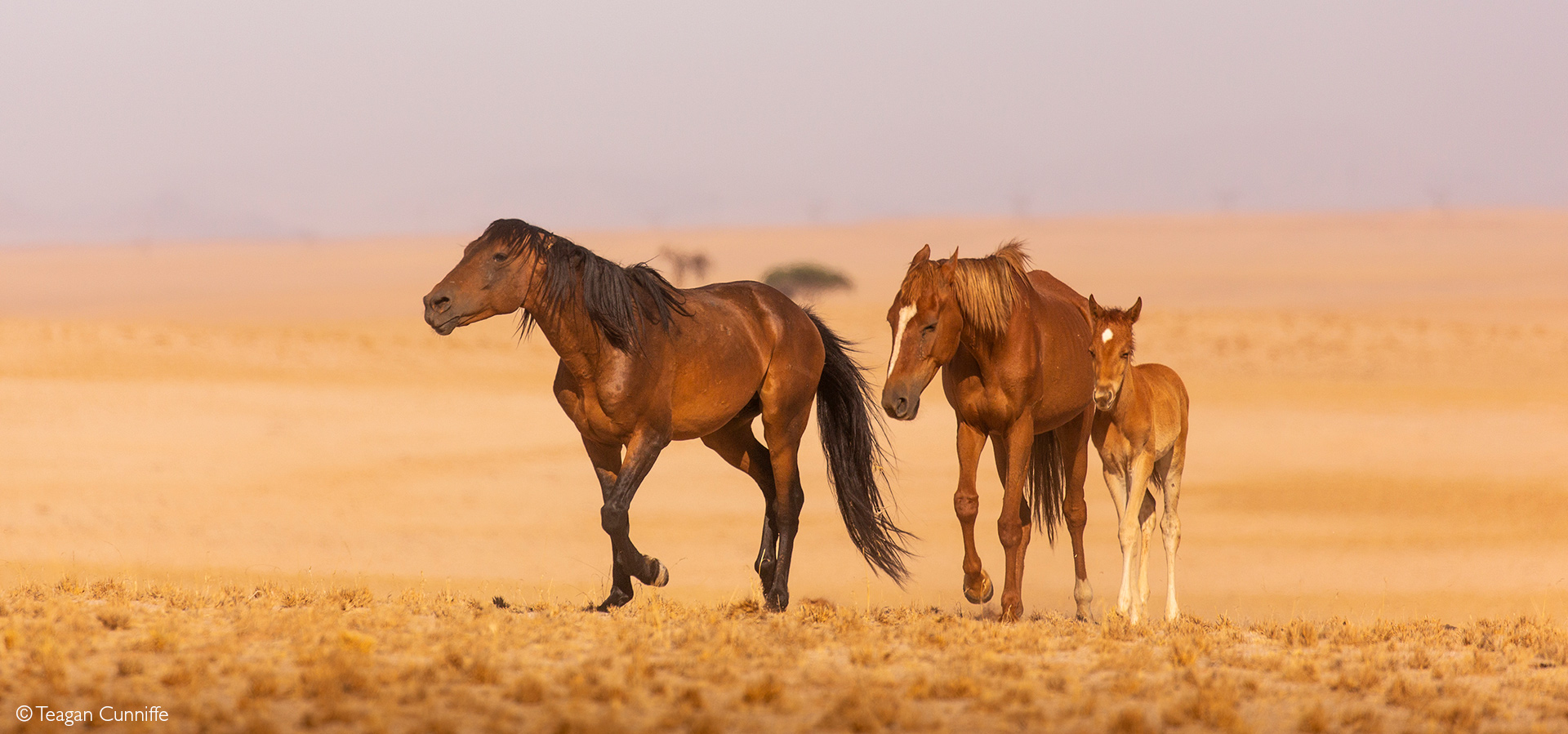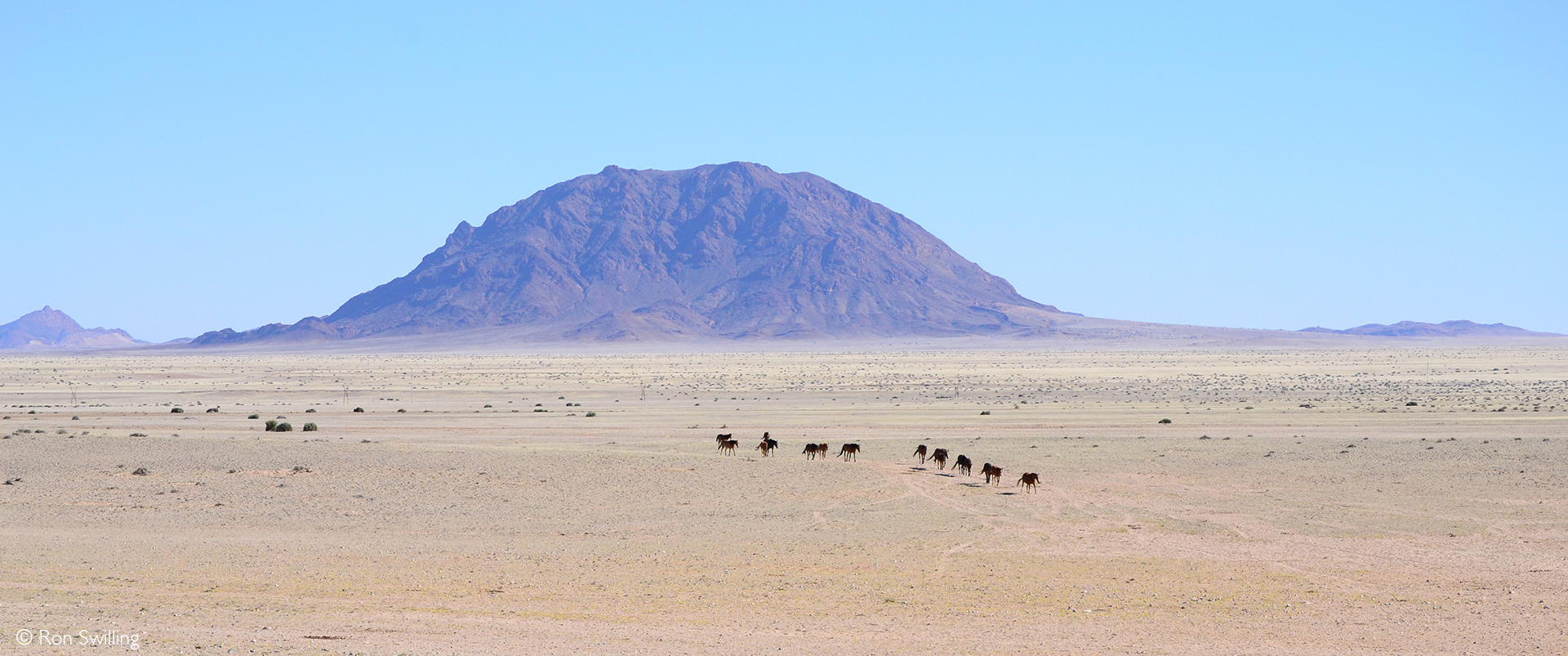
On the brink

OPINION EDITORIAL

On the golden sands of Africa’s ancient Namib Desert in southwestern Namibia, a small century-old population of wild desert horses fights for survival. A corrugated track leads from the main road between Aus and Lüderitz to the Garub hide, overlooking the gravel plains and the waterhole where the horses come to drink. The expanse of dry land is punctuated by the Dikke Willem inselberg and fringed by a series of tawny-coloured rocky hills.
Around the waterhole, narrow ribbons are etched on the sand from years of hoofbeats drumming on the earth. My heart skips along like an excited child. It has become my custom over the last ten years to leave the comfort of my tent at first light to reach the hide by sunrise, where I boil water for coffee on my small gas cooker to warm up from the winter chill, blow on my gloved hands, pull my jacket close to my body and wait for the horses to appear.
The sun peeps from the horizon. And, as if on cue, I catch my first glimpse of a small group of horses in the distance moving towards the waterhole. The wind whips their tangled manes, and dust explodes in puffs as their hooves hit the sand. Nearing the water, they break into a trot and then a gallop. Other groups of horses appear and repeat the performance. I watch the dynamics between them as they meet with greeting rituals and sometimes with a snort and a kick. Taking cover next to the hide to stay out of the wind, I sit in the presence of the horses. As the sun warms their rumps, I soak up the tranquillity of being among some of the last wild equids in Africa.

The extreme elements do not threaten the Namib’s wild horses this time. The cyclic years of drought and abundance are part of life in the desert. This time it is a clan of spotted hyenas targeting the foals one by one, gradually decimating the population and threatening to end the intriguing history of the wild horses, one of southern Namibia’s tourist attractions.
The early morning scene at Garub is one that I have come to cherish through years of research on these horses. The isolated populations of wild horses that grace virtually every continent of the world originate from domesticated horses that have regained their freedom, except the Mongolian wild horse. Very few horses ever have the chance to live naturally – forming bonds, finding partners and being part of cohesive family groups, possibly because wild horses tug at our heartstrings. This is particularly true of the resilient horses that have made their home in the unlikely landscape of the Namib Desert.
The Namib horses are descended from the Kubub stud farm breeding horses, established at the beginning of the twentieth century, only 35km from where they are today. The farm was abandoned during World War One, leaving the unfenced and ownerless horses to follow the grazing. They gradually made their way to Garub, where there was a constant supply of borehole water for the steam trains. Over the years, the desert conditions and droughts kept their numbers low, at around two hundred horses, in proportion to the capacity of the land – and kept their gene pool strong.
According to Dr Telané Greyling, who studied the behaviour of the Namib wild horses extensively and monitored them continuously for 28 years, the Namib horses adapted their behaviour to ensure their survival in the desert, allowing a certain amount of dehydration. This condition would severely stress a domesticated horse.


Initially, the wild horses were protected in the restricted diamond-mining area, the Sperrgebiet, only entering the public arena when sections of the Sperrgebiet became part of Namib-Naukluft Park in the late-70s and -80s. By then, they had lived as a wild population in the desert for more than fifty years. As a game-proof fence, erected on the eastern boundary of the desert in the late 1980s, thwarts the horses’ ability to move inland to find water, they remain in the vicinity of the Garub waterhole, which they visit every two to three days to drink, depending on the weather and the proximity of the grazing.
When the Garub hide was built in 1993, visiting the wild horses became one of the highlights of passing through southern Namibia for many a traveller. Images of the horses were increasingly used in marketing Namibia as a wild, free and rugged destination. In 2012, a group of individuals from the safari tourism, veterinary, environmental management and environmental research sectors established the Namib Wild Horses Foundation. The foundation was set up to monitor the population and assist the Ministry of Environment, Forestry and Tourism (MEFT) in managing the horses, coordinating support for the horses’ long-term sustainability and administering funds from public donations for supplementary feed in times of drought.
At the time of the foundation’s establishment, the desert was experiencing years of above-average rainfall – but a period of drought would soon follow. The drought brought an additional unprecedented threat to the wild-horse population: the appearance of a clan of spotted hyenas drawn to the easily accessible food source.

Until then, hyenas had occasionally passed through the area preying on a foal or weakened horse but didn’t pose a major threat to the population. That changed in 2010 when individuals dispersed from another clan further north and moved into the area around Garub, establishing a new clan. Between 2013 and 2018, not a single foal survived. In 2013 alone, nearly a hundred horses were killed, fifty of them foals. The numbers of the wild horse population plummeted by more than half. The foundation began a series of talks with MEFT to look for solutions to safeguard the future of the population. But without immediate action, the wild horse population nosedived from 286 to a mere 74 horses.
While the humans were locked in discussions, nothing changed at Garub and horse numbers continued to drop.
In 2017, the foundation was granted permission to feed the hyenas as a short-term solution to draw them away from the horses, which it did until the drought broke in 2018. After a short reprieve by the hyenas turning their attention to domestic animals on nearby farms, they began to target the horses again.
In December 2018, when the situation seemed irrevocable, MEFT agreed to capture the hyenas and relocate them to a different area. They also released an official statement acknowledging the Namib horses as a national heritage and an essential asset for tourism, undertaking to ensure their survival.


After unsuccessful attempts to dart the hyenas, the ministry eliminated several animals. In a public meeting held at the end of February 2019, attended by various parties, including predator-interest groups, there was a consensus that the situation could have been averted had it been dealt with and managed before it reached crisis point. MEFT then drew up a management plan for the horse population.
These events silenced the issues for several years until the hyenas started again preying on the foals. And with the horses out of the limelight, the public must be aware that the point of no return is fast approaching. The handful witnessing the population’s demise are losing hope that it will recover with the absence of new foals and the diminishing number of breeding mares.
But, the ray of light remains that the population will still stand a chance of survival if action is taken now. Many believe the clan of hyenas should be relocated. In contrast, others believe the horses should be moved to private land, where they can remain a national treasure and tourist attraction. Both solutions require a green light from MEFT. Until then, as the horses reside in a national park, the fate of the Namib horses hangs in the balance.
On leaving the hide this time, I realise with a sudden pang that although several foals have been born over the summer rainfall months, I haven’t seen a single one in my hours at the hide. I feel a deep sadness wash over me, knowing that this may be one of my last chances to see the Namib horses unless the various stakeholders can work together to find a reasonable outcome that is not merely put down on paper, but followed through with immediate and effective action.
The disappearance of the Namib wild horses would leave an empty blot in the desert where once people entertained magic and magnificence. And the safari industry, too, would feel the loss if these popular icons were to disappear.
 Find out about Namibia for your next African safari (select ‘Namibia’ from the country list), find a ready-made safari or ask us to build one just for you.
Find out about Namibia for your next African safari (select ‘Namibia’ from the country list), find a ready-made safari or ask us to build one just for you.

Editorial note: The opinions offered above are the author’s own. Much debate has evolved from the issues surrounding Namibia’s wild desert horses and to what extent conservation authorities should intervene between endemic wildlife and “feral” animals. What are your thoughts? Share your comments on this story by logging into our app.
To comment on this story: Login (or sign up) to our app here - it's a troll-free safe place 🙂.![]()






